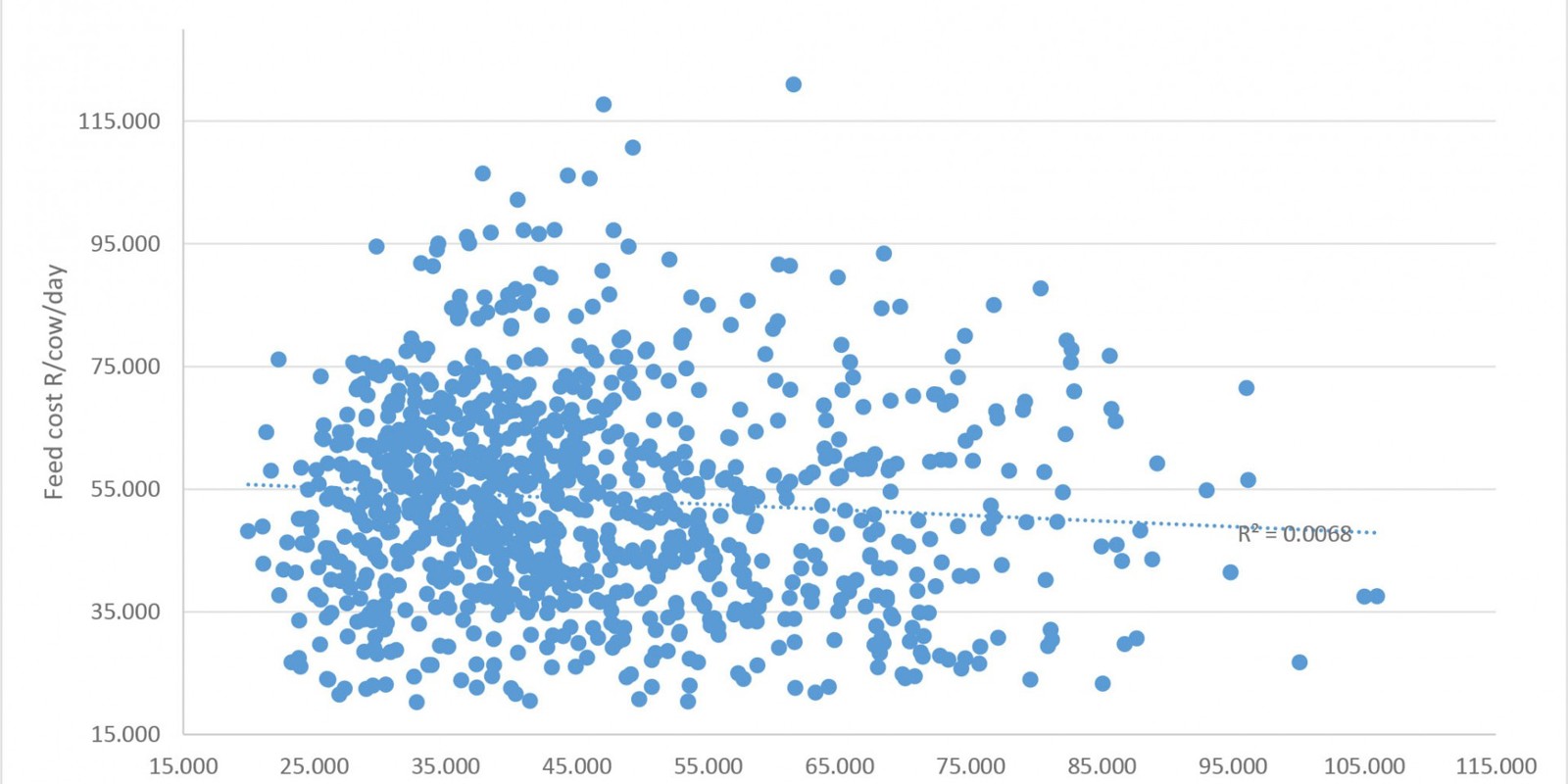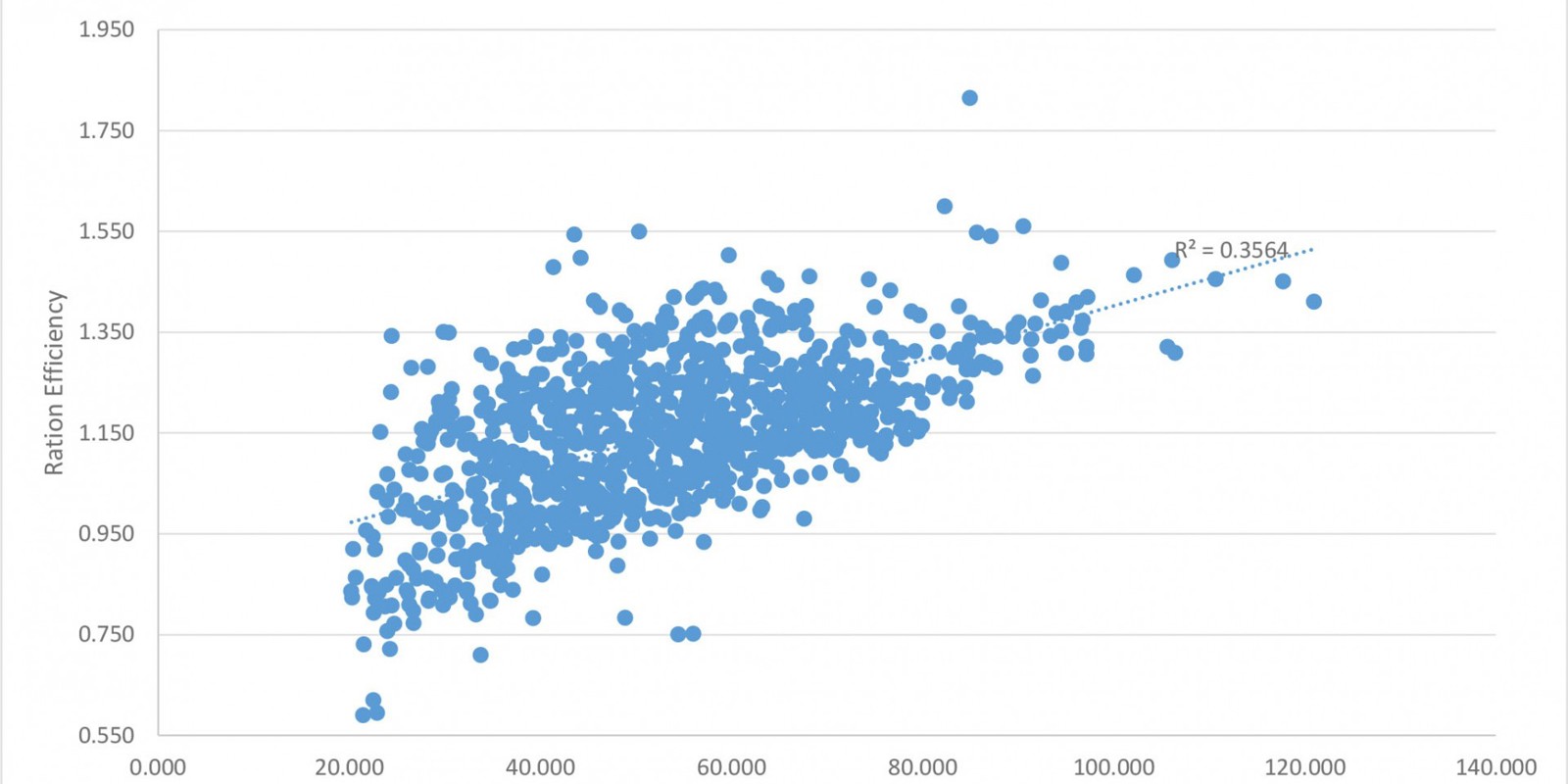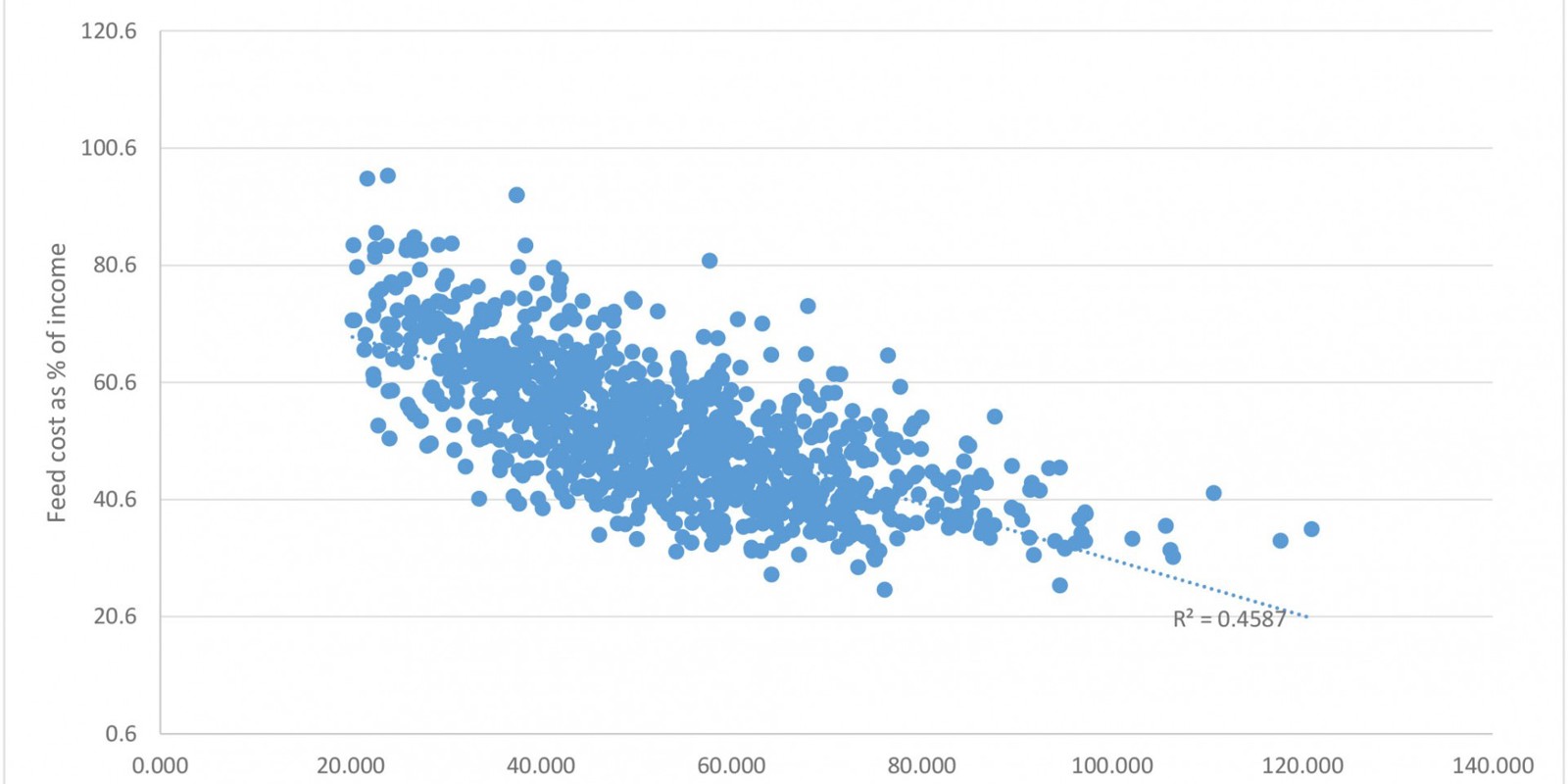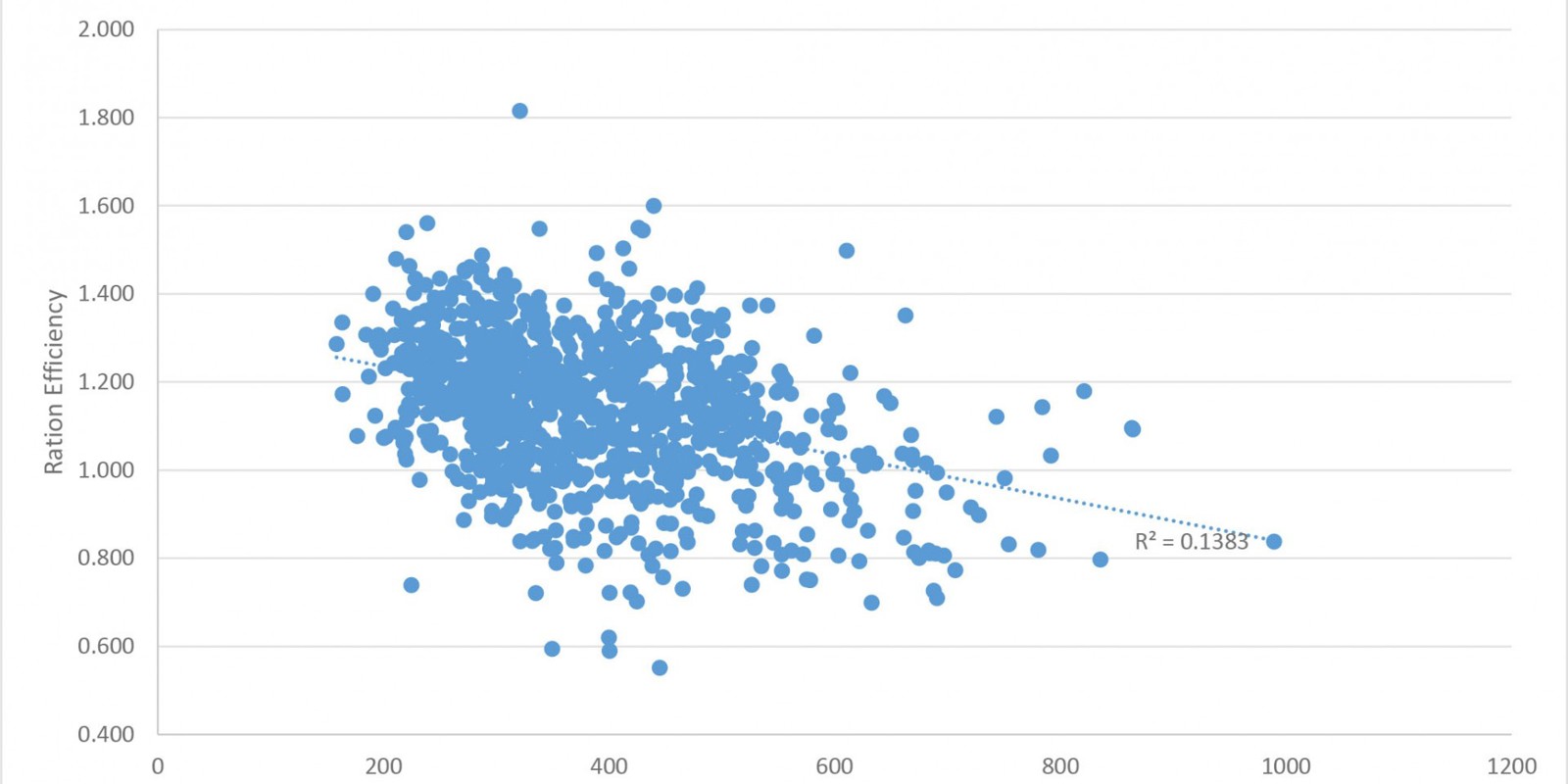Financially streamlining your dairy business
The financial viability of each dairy unit in South Africa comes under more pressure every day. It would seem that the next challenge in the SA dairy industry is never far away and this brings about new plans to be implemented. There are, however, 5 important parameters to keep in mind on a daily basis when assessing you own situation. If you have a partner in the process it also helps and improves your effectiveness and focus.

Margin over Feed Cost
Margin over feed is the term used to describe the capital left after all feed costs have been deducted from the income. This includes ALL feed resources including roughage; not just concentrated feed. Margin over feed gives a good indication of your business’ profitability. It is usually expressed as R/cow/day or R/cow/month. It does also not include fixed costs, but with a fixed cost calculated per cow one can then easily deduct it from this. Margin over feed cost has two major factors affecting it, which is input (feed) costs and income. Manipulating these two factors will improve overall margin, however, this is easier said than done.
Feed cost is difficult to manipulate as a large portion is not controlled by either the farmer or the middle man. Reducing feed costs is also not necessarily ideal when feeding cows as there is a minimum nutrient requirement for any cow and also for a specific production level. Over 16 seasons of recording margin monitors by De Heus over nationwide herds, there is no clear indication that higher feed costs generally have the highest margin or more importantly that the contrary is true in that a lower feed cost does not give a higher margin, as seen in Figure 1.
Figure 1 The relationship between feed cost and Margin
However, looking after your animals usually pays and saving by cutting on feed costs is usually detrimental to factors other than margin. That being said, there are several ways to improve feed costs without cutting corners. Ensuring economy of scale with bigger setups usually allows a farmer the opportunity to bargain more for the price he pays for several products, including concentrate. The farmer may be able to buy and fix prices in advance, for instance, by buying lucern in spring and filling sheds for the whole year. By using the correct feed for each scenario has a huge impact.
The production of more good quality roughage is always extremely important. It is cheaper to produce your own roughage than to buy it in and if the quality is good it reduces the cost required for additional concentrates. Wastage is probably one of the most overlooked aspects of feed costs and it is a big problem in South Africa. What percentage of feed is wasted in storage, in mixing and in the feeding process? If only 10% of feed ends up next to feed troughs and the average feed cost of a cow is R50/cow per day the wastage amounts to R5/cow/day. In a 300 CIM (cows in milk) herd this would amount to R547 500 loss per year.
The act of improving one’s income also has its challenges and this is often controlled by someone other than the farmer. The most important thing is to tackle the parts which can be controlled. Income could be broken down into two basic factors; the amount for product produced to sell and the selling price for the said product. In the farmer’s case this is milk production and milk price.
To improve efficiency, nutrition, genetics and management all factors should be addressed on a daily basis in order to improve production and production efficiency. Improving the milk price is a possibility for the farmer. It’s however important to understand what you are paid for and which factors your individual milk buyer requires. Milk quality can be improved to a degree with nutrition and to a large degree with management and this will improve the milk price. Economy of scale can also manipulate the milk price.
Ration Efficiency
Ration efficiency, also known as feed efficiency or feed conversion ratio, is a critical assessment in a dairy herd to see if production is on par or not. In layman’s terms it’s the amount (kg) of fat and protein corrected milk produced from one kilogram of dry matter intake. The average figure over a herd is usually between 1,10 and 1,20, however, herds often go over the 1,50 mark.
Although this is different in theory it again comes back to input vs output. Improving efficiency has mainly to do with management aspects and improving all factors that make cows less efficient will help to tackle this. Improving efficiency of digestion is a key aspect and all factors that influence this, such as improved rumen function, improved roughage quality, heat stress management, housing, bunk space management, feeding regime, walking distance, competition, wastage or any other factor that decreases cow efficiency.
Improving the efficiency with which a cow utilizes a ration is usually a double-edged sword and leads to reduced intake or similar intakes, but with improved production or often with both. If one takes into account the factors discussed in Margin over feed it is fairly straightforward that an improved ration efficiency will directly contribute to improved Margin over feed costs and profitability. This is illustrated in Figure 2 where 16 seasons’ margin monitor data is considered to indicate a trend towards improved margin when ration efficiency is improved. It is an effective tool to see where your attention should be focused in your herd to resolve efficiency issues.
Figure 2 Ration efficiency compared to Margin over several seasons
Feed Costs as a Percentage of Income
Feed costs as a percentage of income is an indication of what proportion of your income is consumed by feed costs. As can be seen in Figure 3, it is indirectly correlated with margin and does give an indication of the ability of the business unit to absorb additional stressors or increases. If two farms had the same margin yet one had a much lower feed cost as a percentage of income it would then have the ability to absorb feed price increases or manage a decrease in milk price better than the farm with the same margin but a higher feed cost.
Care should be taken that a low feed cost as a percentage of the income is not achieved by underfeeding cows. It might be misleading, as cows can maintain condition for a while but other factors such as fertility and health will suffer as a consequence, leading to problems at a much later stage.
Figure 3 The correlation between feed cost as % of income to margin over feed cost
Gram / ℓ
It is the grams of concentrate feed needed to produce one litre of fat and protein corrected milk. This excludes all roughage and includes all forms of concentrated feed. The gram per litre figure is another valuable measuring instrument to determine the efficiency of a herd. It shows how efficiently you are utilizing the concentrate feed (usually the most expensive feed resource) in milk production. It would seem that it will be indirectly correlated to ration efficiency and it is but with a very low r2 value, meaning it’s by far not the only factor affecting ration efficiency and is generally only a part of it and therefore all parameters should be considered together.
Figure 4 the effect of concentrate feed per litre of milk on ration efficiency
Benchmarking
When it comes to analysing the financial aspects of dairy business units, several parameters are important and although these depend on the farm or the setup, five completely different parameters can be relevant for each factor that remains unchanged and important is being able to benchmark and compare. If farmers have a platform or relationship with a company where they can compare between different business units and learn from the comparison it is vital for growth and for taking your own system forward. The De Heus Milk Margin Monitor is such an example and it enables you to see which areas of your business you need to improve. This can only be beneficial and although all aspects cannot always be fixed in a day, it gives a focus point to work towards.
To conclude, one needs to understand that in the end one needs to make money from one’s business. Whatever the aspects are that you are focusing on, make sure they are relevant to your business and help to improve the financial well-being of your dairy. Make sure you take action regarding the aspects you are focusing on as opposed to just taking note. Lastly, make sure that your business partners are focusing on the same aspects and understand what is important to you.




